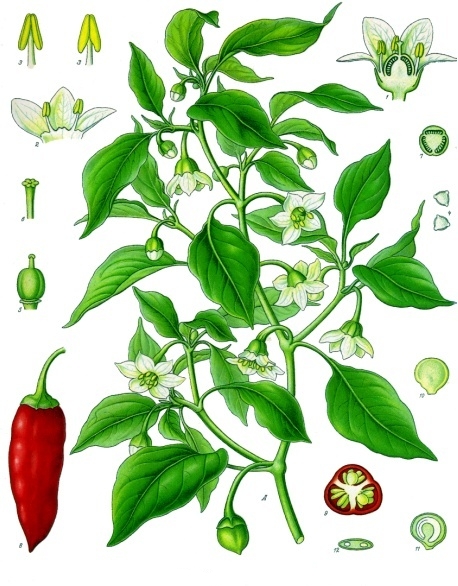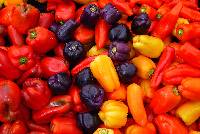
| 1. Capsicum frutescens L. Sp. Pl. 189. 1753; Seem, in Bonplandia 9: 258. 1861, Viti, 440. 1862, FI. Vit. 177. 1866; Engl, in Bot. Jahrb. 7:473. 1886; Drake, Ill. FI. Ins. Mar. Pac. 248. 1892; Reinecke in Bot. Jahrb. 25:674.1898; Witasek in Denkschr. Akad. Wiss. Wien 85: 342. 1910; Greenwood in Proc. Linn. Soc. 154:102. 1943; Yuncker in Bishop Mus. Bull. 178: 105. 1943, in op. cit. 184:61. 1945, in op. cit. 220: 237. 1959; J. W. Parham, Pl. Fiji Isl. 237. 1964, ed. 2. 328. 1972; Backer & Bakh. f. FI. Java 2: 469. 1965; Purseglove, Trop. Crops, Dicot. 526. fig. 84, B. 1968; Heiser & Pickersgill in Taxon 18:280. fig. 1, 2. 1969; Sykes in New Zealand Dept. Sci. Indust. Res. Bull. 200: 192. 1970; B. E. V. Parham in New Zealand Dept. Sci. Indust. Res. Inform. Ser. 85:102. 1972; D’Arcy in Ann. Missouri Bot. Gard. 60:594. 1973; Heine in FI. Nouv.-Caled. et Depend. 7:204.1976; Symonin J. Adelaide Bot. Gard. 3: 137. 1981; Purdie et al. in FI. Australia 29: 178. 1982; Symon in J. Adelaide Bot. Gard. 8:10. 1985; Morat & Veillon in Bull. Mus. Nat. Hist. Nat. (Paris) IV. 7, Sect. B, Adansonia 3: 318.1985; MacKee, Pl. Intro. Cult. Nouv.-Caled. 124. 1985. Coarse, perennial, suffrutescent herb or low shrub 0.6-2 m. high, freely escaped from cultivation and naturalized in coconut plantations, cultivated fields, and clearings, and along rocky coasts and on open hillsides from near sea level to about 400 m. The corolla is greenish white or pale yellow, the anthers are blue to violet, rarely yellow, and the fruits become red. Flowers and fruits are seen throughout the year. Lectotypification: Heiser and Pickersgill (1969) indicate as lectotype the specimen of Capsicum frutescens in van Royen’s herbarium (l). Distribution: Probably originating in South America but early widespread throughout the New World and subsequently into all tropical and subtropical areas. Local names and use: Fijian names are mboro, mboro nganga, mboro ni vava- langi, and rokete; also known as mircha (Hindi), chilli, birds-eye chilli, birds-eye pepper, bird pepper, and hot pepper. The edible fruit is used as a pungent condiment. Available collections: VITI LEVU: Mba: Lautoka, Greenwood 221. Nandronga & Navosa: Singa- toka Experiment Station, DA 5948. Ra: Penang, Greenwood 221A. Rewa: Department of Agriculture compound, Suva, DA 12187. KANDAVU: Western end of island, near Cape Washington, Smith 304. OVALAU: North of Levuka, Gillespie 4499. NGAU: Sawaieke, shore of Herald Bay, Smith 7933. TAVEUNI: Somosomo, Seemann 346; Waiyevo, Gillespie 4656.1. MATUKU: Bryan 285. LAKEMBA: Near Tumbou Jetty, Garnock-Jones 934. |
Capsicum frutescens is native to the New World tropics, but is now widely distributed throughout the warm regions of the world. It was an early European introduction to Tonga, where it is grown in villages for its spicy fruit, but escapes from cultivation and becomes somewhat weedy in disturbed places. The fruit contains a powerful local stimulant known as capsaicin, which, when applied to the skin, produces a sensation of warmth without reddening, and in higher. concentrations, an intolerable burning sensation, without, however, blistering.
The plant is a woody, branching shrub up to 2 m in height. The simple, alternately arranged leaves have an ovate to lanceolate blade 4‒12 cm long. The flowers are 1‒3 in the leaf axils, reflexed atop a stalk mostly 1‒2 cm long. The greenish white, rotate corolla is ca. 1 cm in diameter, with five yellow stamens. The fruit is a red, ovoid to ellipsoid berry 1.5‒3 cm long, with a very pungent taste.
Copyright ©2018. This project is managed by the St. George Village Botanical Garden and the portal development is powered by Symbiota software. Usage Policy.



